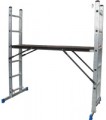Design
In this paragraph, the main properties of the design of the stairs are given. Many models have several properties at once — for example, any sliding ladder will be at least attached, and transformer models combine attached, parted, and in some cases also sliding structures.
— One-
way parting. A variety of ladders and mini-ladders (see "Type"), in which the steps are located on only one of the two components. Such models are lighter than double-sided spacers, but may be less convenient to use.
—
Bilateral parting. This category includes options consisting of two parts, each of which has its own set of steps — in other words, from two separate stairs connected into one device. Unlike one-sided, a similar design is found in all types of stairs, and for transformers it is almost mandatory.
—
Attached. Stairs that require additional support for installation in the working position — a wall, a fence, a tree, etc. Specifying an add-on structure in rack-and-platform models (see above) usually means that one or both legs can be used as a separate ladder. But in stepladders, this option is not found by definition.
—
Sliding. Such models have at least one additional section (see "Number of sections"), which is able to extend partially or completely, thus increasing the length of the entire staircase. When a longe
...r length is not required, this section (or sections) is located close to the main part of the stairs and has almost no effect on its dimensions. This design has gained wide popularity in models designed for high heights — after all, long stairs would be very inconvenient during transportation and storage if it were not for the possibility of folding.
— Hinged. Stairs in which several sections are interconnected by means of hinges. In two-section models, this does not give any fundamental differences from non-hinged fastening, but if there are three or more sections, additional possibilities for transforming the stairs may appear — the hinge allows you to rotate the sections in both directions relative to each other. At the same time, the transformation of such a structure into a working platform takes much less time than unfolding a rack with a platform (see "Type").
— Telescopic. A specific type of sliding stairs (see above). It differs in that the additional sections in the folded state are not located close to each other, but one inside the other (hence the name). Thanks to this, telescopic ladders take up a minimum of space and are very convenient to transport. On the other hand, they are quite expensive. This is due to both the overall complexity of the design and the fact that the inner sections must be thin (in order to fit inside the outer ones) and at the same time strong, which puts forward increased requirements for the strength of materials.
— Mobile. This feature means the presence of special devices that facilitate movement from place to place in the working position — for example, castors. It is found mainly among scaffolding (see "Type"): unlike more traditional ladders, carrying spread out scaffolding on weight is rather difficult, and folding into the stowed position and unfolding back takes a lot of time. In addition, wheels are found in some large and heavy ladders.
Number of steps
The total number of steps provided in the design of the stairs. This parameter is indicated rather for reference — the primary characteristic is still the height of the stairs. Note that when calculating the number of steps, the footboard is also taken into account (see below).
Dimensions (folded) (LxW)
Ladder dimensions in fully folded position. The smaller they are, the more convenient the ladder will be in storage and transportation. Usually, only the length and width are indicated in the characteristics, because. the thickness of modern stairs is very small and in most cases it can be neglected; and in some models, only the length may be indicated at all — for the same reasons.
Base Width
The width of the stabilizer provided in the design of the stairs.
The stabilizer is a device placed at the base of the structure and playing the role of a support. The most popular type of such a device is a horizontal bar, which protrudes noticeably beyond the width of the staircase itself; but there are other options (even a part of the stairs extended downwards, which does not have additional details, can be considered a stabilizer). Anyway, the stabilizer makes the structure more stable and reduces the likelihood of lateral rollover. And the larger its width, the higher the stability. On the other hand, too wide stabilizers would be too bulky, so in most models this figure does not exceed 1 m; larger supports are found mainly in "large-caliber" ladders with a large height, from 7 m or more, as well as racks with a platform (see "Type").
Weight
The total weight of the ladder. On the one hand, the lighter the model you choose, the more convenient it will be to carry, the less effort will be expended. On the other hand, lighter weight means less material used in the construction of the stairs, and this can adversely affect reliability. Therefore, it is worth choosing an option for this parameter depending on the planned features of the application. If the expected load on the ladder is significantly lower than the maximum, then you can not pay close attention to the weight. But if you have doubts and/or plan to work in difficult conditions with a heavy load, you should choose the more massive one from two models with the same characteristics. It is unlikely that this will seriously affect the cost of forces, but the risk of breakage and a dangerous fall will decrease significantly.

